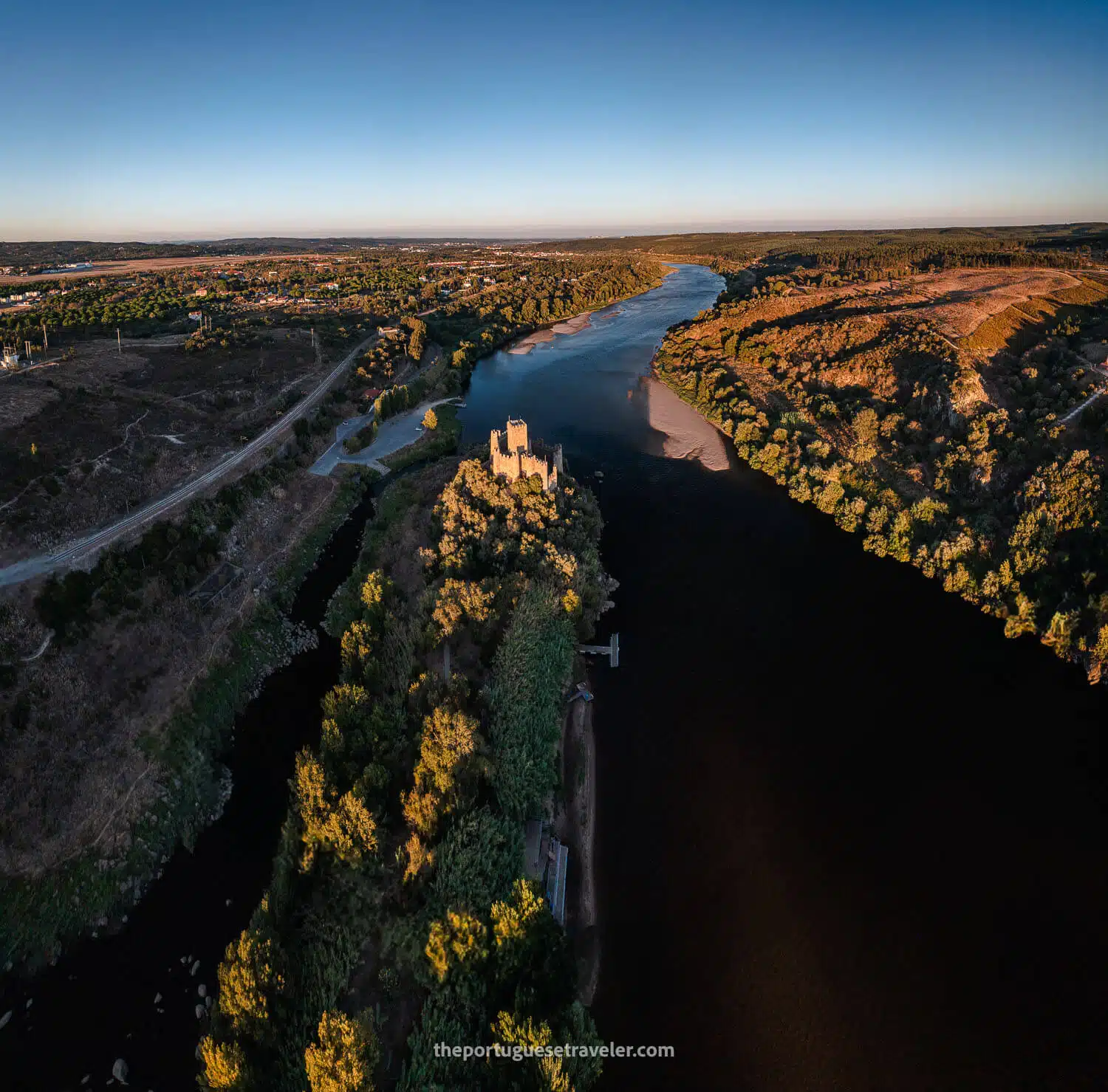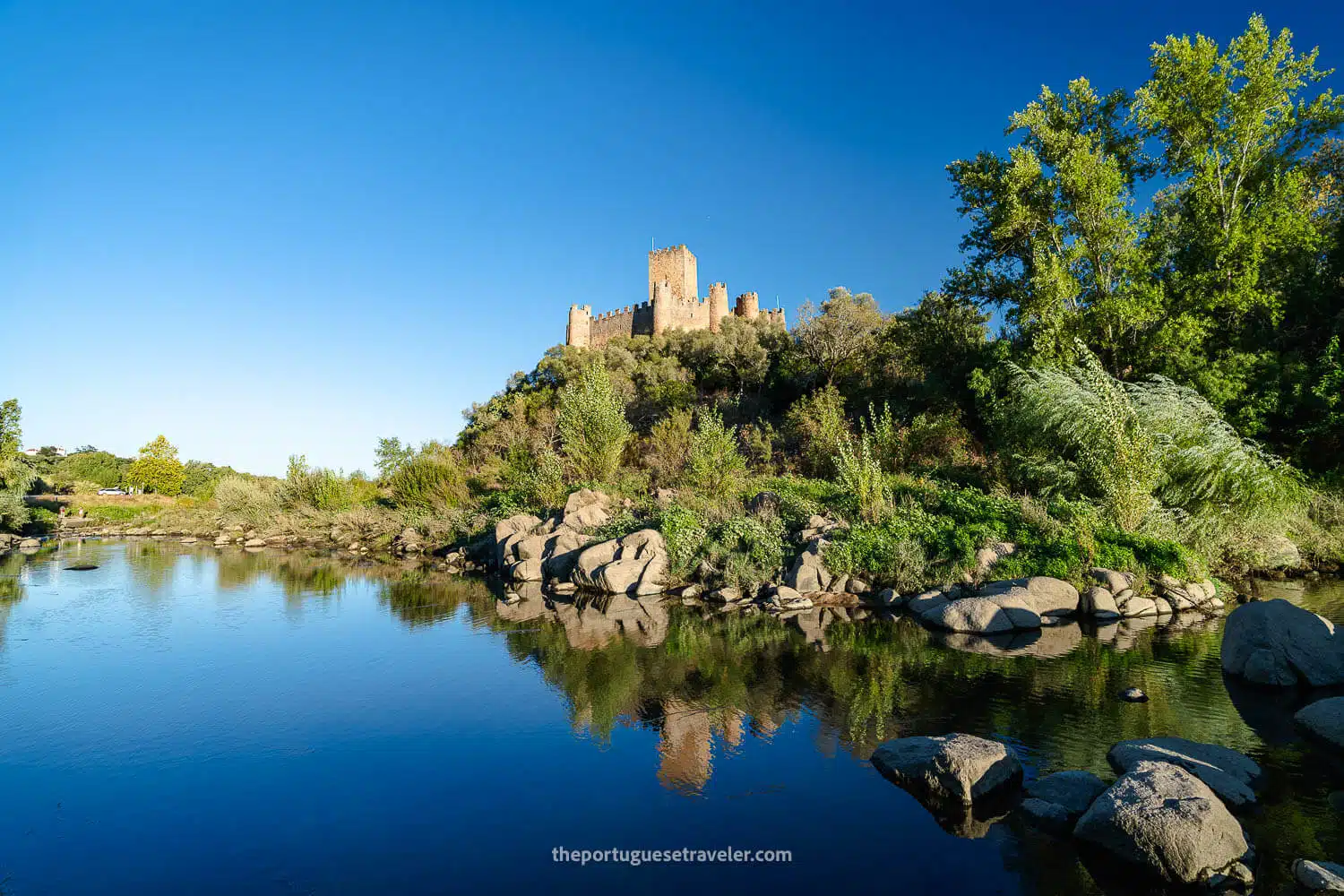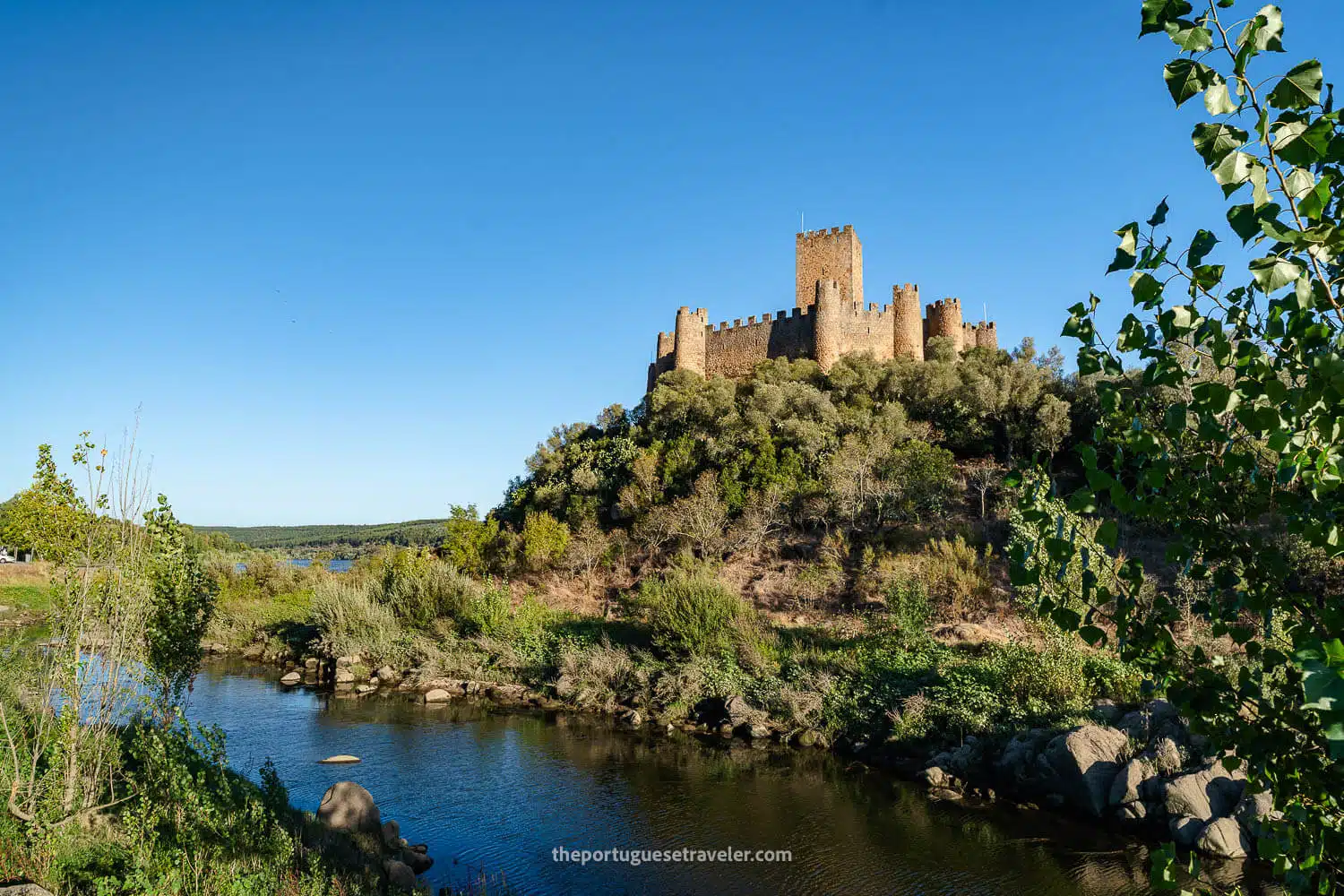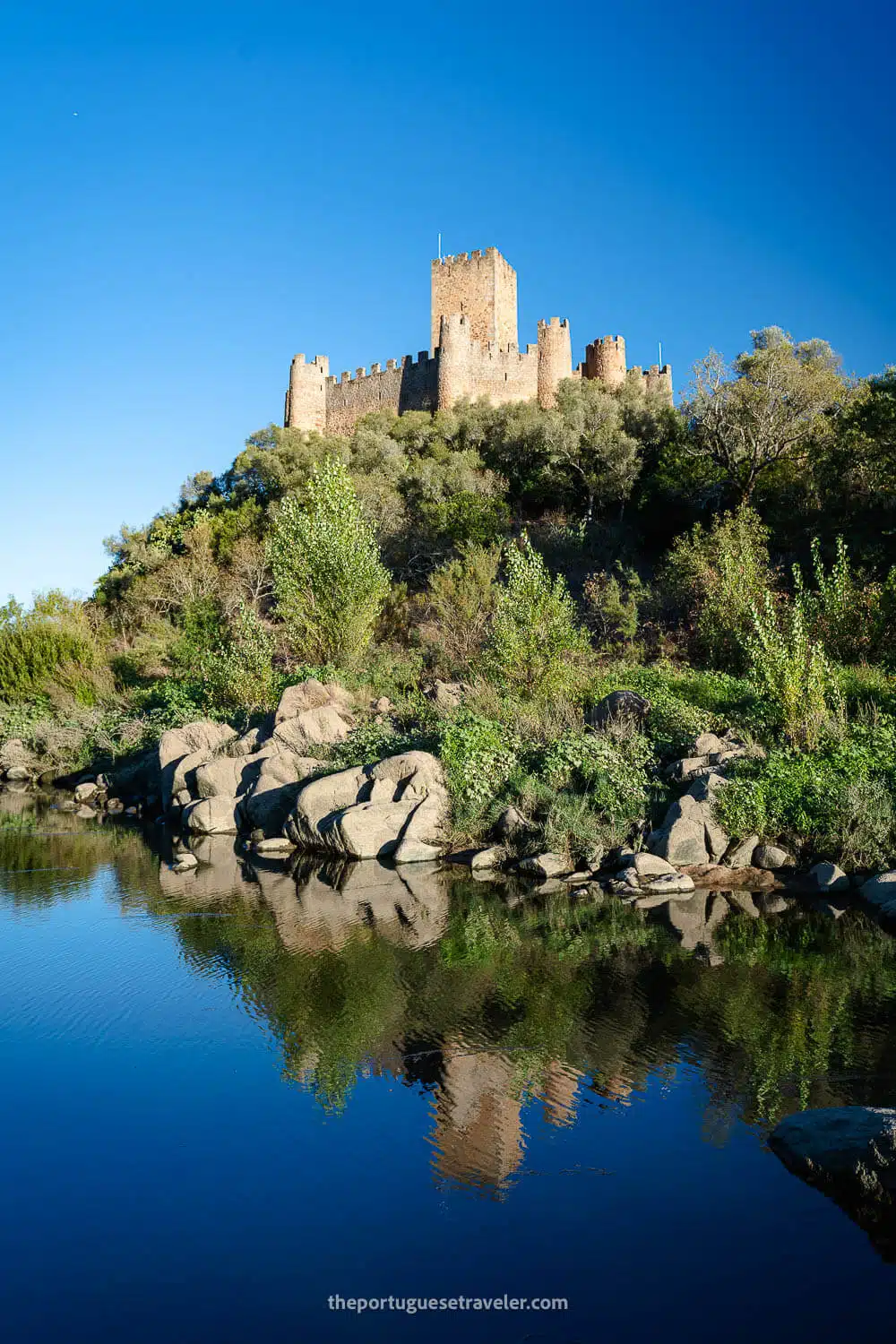Almourol Castle, in Portugal
Complete Guide (2025)

Almourol Castle, or “Castelo de Almourol,” sits majestically on a small granite islet in the middle of the Tagus River, offering a unique glimpse into Portugal’s rich history. The name “Almourol” likely comes from the Arabic “Al-morolan,” meaning “high stone,” hinting at its ancient roots. Originally constructed before 1129, the castle was rebuilt by the Templars in 1171, serving as a stronghold during the Christian Reconquest and guarding vital trade routes.
This enchanting location is not only a historical gem but also a place of legends and mysteries. Tales of tragic knights and beautiful maidens haunt its stone walls, adding an air of intrigue to your visit. Today, the only way to explore this captivating site is by boat, with a short tour lasting less than an hour. You can also kayak or try stand-up paddleboarding around the castle, making for an exciting day on the water.
As the first article in a series highlighting almost 200 castles of Portugal, this post will delve into Almourol Castle’s fascinating past, its architectural wonders, and the magical experiences awaiting visitors. Get ready to embark on a journey through history and adventure!
Table of Contents
Almourol Castle: General Details
Here’s a quick overview of what you need to know about Almourol Castle, including highlights, activities, entrance prices, and opening hours:
- Highlights: Almourol Castle, Tagus River, Almourol Templar Interpretation Center (CITA).
- Entrance Price: 4-6€ (details below)
- Boat Tour Duration: Less than 1 hour.
- Activities: Boat Tour, Kayak/Canoe, Stand-Up Paddle.
- Opening Hours: February: 10:00 – 13:00 | 14:30 – 17:30 / March-October: 9:30 – 13:00 | 14:30 – 18:30 / November-January: 10:00 – 13:00 | 14:30 – 17:00 – (Closed on Mondays from 1st October to 28th February)
- Recommended Agencies for Activities: Tritejo, Aventur.
For more information please get in touch with the local tourism board on their official website or through the following contacts:
Useful contacts:
Almourol Templar Interpretation Center (CITA)
- Location: Centro Cultural de Vila Nova da Barquinha, Largo 1.º Dezembro, 2260-403 Vila Nova da Barquinha.
- Winter Hours (October – February, closed on Mondays):
- Tuesday to Friday: 09:00 – 12:30 | 14:00 – 17:30
- Saturday, Sunday, and holidays: 10:00 – 13:00 | 14:30 – 17:30
- Summer Hours (March – September, open daily):
- Monday to Friday: 09:00 AM to 12:30 PM and 2:00 PM to 5:30 PM
- Saturday, Sunday, and holidays: 10:00 – 13:00 | 14:30 – 18:00
- Contact: T (+351) 249 720 353
Tourism Office in Vila Nova da Barquinha
- Location: Centro Cultural de Vila Nova da Barquinha, Largo 1.º Dezembro, 2260-403 Vila Nova da Barquinha.
- Contact: T (+351) 249 720 353 / 249 720 358.

Almourol Castle: History & Curiosities
Name Origin:
- The name “Almourol” likely derives from the Arabic Al-morolan (“high stone”). Variations include Almoriol, Almorol, Almourel, and Almuriel. Other theories connect it to terms like “Moron” or “Muriella.”
Location:
- Situated on a small granite islet in the middle course of the Tagus River (Rio Tejo), the castle is located in Praia do Ribatejo, Vila Nova da Barquinha, Santarém District, Portugal.
- Often attributed to Tancos, the nearest town, due to visibility from there.
Construction Date:
- Originally constructed before 1129, with significant reconstruction by the Templars in 1171 under Gualdim Pais.
Architectural Style:
- The castle is an example of Templar military architecture, featuring a quadrangular layout, high walls with nine circular towers, and a central keep (torre de menagem).
- Built in granite and mortar masonry, the structure showcases elements from Roman to medieval times, with modern decorative elements added during the 19th-century Romanticism movement.
Historical Significance:
- Pre-Portuguese Era: Before the Portuguese conquest, there were likely Moorish fortifications or a castle on the site, part of the Muslim control in the region.
- Conquered by Portuguese forces in 1129 during the Christian Reconquest, Almourol became a Templar stronghold. It controlled trade routes and protected Portuguese territories between the Mondego and Tagus rivers.
- After the dissolution of the Templars in 1311, the castle was incorporated into the Order of Christ.
Legends and Mysteries:
- D. Ramiro’s Tragedy: A Christian knight who killed two Moorish women and later captured a Moorish youth. The prisoner poisoned the knight’s wife, but fell in love with his daughter, escaping with her. The legend claims the couple’s spirits are seen atop the tower on St. John’s Night.
- The Emir and His Daughter: An Arab lord and his daughter leaped from the castle walls into the Tagus River, preferring death over capture by a Christian knight who betrayed them.
- Palmeirim’s Adventure: In literature, the giant Almourol is a character guarding a princess in the castle, leading to legendary duels and victories by noble knights.
Topography:
- Perched on a granite outcrop, 18 meters above water level, the island is about 310 meters long and 75 meters wide, making the castle’s positioning highly defensible and visually striking.
Strategic Role:
- During the Reconquista, the castle was part of the “Linha do Tejo,” a defensive line protecting the newly-formed Portuguese kingdom from southern incursions.
Evolution Over Time:
- Damaged in the 1755 earthquake and later restored during the 19th-century Romantic movement, which added crenellations and battlements to enhance its medieval appearance.
- Adapted to be used as the Official Residence of the Portuguese Republic during the Estado Novo regime in the 20th century, where significant official events took place.
- Used by the Portuguese army under the command of the Engineering School of Tancos.
Cultural Status:
- Declared a National Monument in 1910.
- One of the 21 finalists for the “7 Wonders of Portugal” in 2007.
- In 2013, it was named “Star of the Médio Tejo” for its historical significance.
Restoration and Tourism:
- Extensive restorations took place in 2013-2015, focusing on structural repairs and creating a museum exhibit in the keep.
- Further improvements in 2018 included enhancing access and creating a Templar Interpretation Center.
- A popular tourist site, it can be visited by boat tours from Tancos or Arripiado, allowing visitors to experience the scenic beauty of the Tagus River and the castle’s historical ambiance.
Recent Developments:
- Integrated into the Tejo Panoramic Trail in 2022, a 10.5-kilometer trail that can be walked or cycled, providing visitors with stunning views of the Tagus River and the surrounding cultural landmarks.


How to visit Almourol Castle
You can explore on your own by taking a public boat to the castle or just spend time in the area in front of it. You can also head to the other side of the Tagus River, where you can visit the beach or the Miradouro do Almourol.
Alternatively, you can join a tour from Lisbon, combining the Knights Templar Tour in Tomar and Almourol, or visit other popular spots like Fátima, Batalha, Nazaré, and Óbidos.
No matter how you do it, visiting Almourol Castle is definitely worth it—you’ll only regret it if you miss out when you have the chance.
Making the Most of Your Almourol Castle Trip
What Can I See at Almourol Castle?
At Almourol Castle, visitors can admire the impressive Templar military architecture, including high granite walls, nine circular towers, and a central keep. The views from the top offer a stunning panorama of the Tagus River and the surrounding landscape. While the castle itself doesn’t house a museum, the nearby Templar Interpretation Center (CITA) in Vila Nova da Barquinha provides valuable insights into its rich history and legends.

How much does it cost to visit Almourol Castle?
Visiting Almourol Castle offers several options to explore this stunning historical site, and the pricing varies depending on the type of tour or activity you choose. Here’s a detailed breakdown:
From the Castle’s Dock:
- Includes: Entrance to the island and the castle, plus admission to the Almourol Templar Interpretation Center (CITA).
- Price: €4 per person.
- Capacity: Boats hold up to 20 people.
From the Castle’s Dock:
- Includes: Scenic river tour starting from Cais D’El Rei in Tancos, with a stop for visiting the island and castle, and entry to the CITA.
- Pricing:
- €6 per person for groups of up to 5.
- €5.50 per person for groups of 6 to 14.
- €4 per person for groups of 15 or more.
- Capacity: Boats hold up to 50 people.
- Reservations: Can be made through Junta de Freguesia de Tancos at T (+351) 249 712 094 or [email protected].
Solar-Powered Boat Tour:
- Duration: About 1 hour and 45 minutes (including the castle visit).
- Price: €10 per person.
- Extras:
- Castle Entrance: €4 per person.
- Onboard guided tour: €2.50 per person.
- VIP treatment (local wine or liqueur with snacks): €3 per person.
- Capacity: Limited to 12 people per tour.
Traditional Boat Tour:
- Duration: About 1 hour and 45 minutes (including the castle visit).
- Price: €6 per person.
- Castle Entrance: €4 per person.
- Capacity: Limited to 12 people per tour.
Epic Sunset Boat Tour:
- Duration: Approximately 2 hours (timing to be confirmed).
- Price: €24 per person for groups of up to 2; €20 per person for groups of 3 to 8
- Capacity: 8 to 10 people per tour.
Stand-Up Paddle:
- Program 1 – Almourol à Vista:
- Start: Tancos.
- Duration: 1.5 hours.
- Price: From €35 per person (for 2-4 participants).
- Includes: Castle Visit.
- Program 2 – Raid to Almourol:
- Start: Constância.
- Duration: 1.5 to 2 hours.
- Price: €40 per person (for 2-4 participants).
- Includes: Castle Visit.
Canoeing:
- Descida do Almourol:
- Start: Constância to Tancos or Vila Nova da Barquinha (6-8 km).
- Price:
- Up to 5 participants: €15 per person.
- 6 participants or more: €12 per person.
- Afternoon descents: €10 per person.
- Canoeing with meal options available.
Payment and Reservations
- Payments are typically made at the time of boarding. Reservations are required and can be made via email or booking forms provided by the agencies.
Where to Park near Almourol Castle
There is a large parking lot next to the Almourol Castle dock, which offers stunning views of the castle itself. This makes it an ideal spot to leave your vehicle while exploring the castle and enjoying the scenery. The parking area is easily accessible

Amenities at the Almourol Castle
Right by the castle parking lot, the Bar do Castelo restaurant offers food and drinks, along with restroom facilities (WC).
In addition to this, the nearby villages of Tancos, Constância, and Vila Nova da Barquinha have a variety of amenities, including restaurants, ATMs, and pharmacies. Whether you need a quick bite, cash, or any essentials, these villages have you covered.

Where to Stay near Almourol Castle
You can either sleep at Constância, Tancos, or Vila Nova da Barquinha.
If you prefer larger towns Tomar, Entroncamento or Abrantes are nice options.
If you’re just on a day trip from Lisbon then you might find these articles useful:
How to get to Almourol Castle:
From Lisbon:
By Car: It takes around 1 hour and 30 minutes to reach Almourol Castle. Start by taking the A1 highway for approximately 100 km, then exit onto the A23 towards Abrantes/Castelo Branco/Torres Novas. After about 20 km, take the N3 exit towards Fonte Santa – Castelo de Almourol.
By Public Transport: There are several trains and buses available to reach the castle. From Santa Apolónia station, take the CP Alpha Pendular or Regional Train towards Porto Campanhã and get off after approximately 1 hour at Entroncamento. From there, catch the Regional Train to Badajoz and get off after two stops (about 10 minutes) at Almourol. The castle is a 17-minute walk from the station.
You can also take a Rede Expressos or Alsa bus to Abrantes or Torres Novas, and then get off earlier or transfer to a local bus to Almourol.
Each way should cost around 10-11€ – You can buy your train or bus tickets directly at Omio – I personally always book with them because sometimes you can find buses you didn’t know about or get discounts, making it really convenient to use.
Other Attractions near Almourol Castle
Here is a short list of what other interesting things you can see around the Almourol Castle. If I’d extend the radio a bit more the list would be endless.
Cultural & Religious:
Castles and Fortifications:
Nature Reserve – Animal Observatory:
Roman Ruins:
Ruínas da Cidade Romana de Escora
Swimming/Beaches:
Porto das Mulheres Beach
Neolithic Remains:

Check this All-Inlcusive Tour from Lisbon
What clothing should i bring to Almourol Castle?
It really depends on what activity you’re doing there. If you’re just visiting by public boat and taking some photos then:
- Sunscreen – Ensure you have a minimum of SPF 20/30.
- Camera – Don’t forget to bring your camera, phone, or a GoPro to catch some nice shots of this fairytale castle.
- Outfit – Depends on the weather
If you’re doing Kayak or Stand-Up Paddle then you might want to consider some of these items:
- Tshirt: Breathable Tshirt (Tech or Merino), or a Lycra
- Jacket: Waterproof Jacket
- Shorts: Swimming Clothes
- Shoes: Hiking Shoes, and Flip Flops
- Hat: Cap
- Sunglasses
- Dry-fast Towel
- Earth Pak Waterproof Dry Bag
- Change of Clothes
Check out my complete guide on What’s in My Backpack – From photography gear, and clothing for Hiking, Mountaineering, Scuba Diving, Rainforest, and City-Street Photography.

My Experience on the Almourol Castle
We visited Almourol Castle on a one-day trip from Lisbon. We first drove to Torres Novas to see its castle, and what a treat that was! I was eager to try flying my drone there and capture a bird’s-eye view. Luckily, despite concerns that it might have been damaged during our trip to Greece earlier this summer, after a proper calibration, it worked flawlessly. The plan was to visit Torres Novas Castle, check out the Villa Cardilium Roman ruins, and then head to Almourol Castle at sunset for some epic shots. However, we ended up skipping the Roman ruins to have lunch and relax a bit. We dined in Torres Novas’ main square in front of the castle, then went straight to Almourol.
We arrived about an hour before sunset, parked at the lot near the dock, and were amazed by how beautiful and scenic the castle was. It was my first major photography goal in Portugal. We scouted around, found some great compositions with the castle’s reflection in the river, and finally, I decided to fly my drone.

I was initially worried that I wouldn’t be able to fly it due to the nearby Tancos Military Airfield, but after going through some authorization steps via my phone and drone controller, I managed to get DJI clearance. Hopefully, one day I’ll get the necessary Portuguese ministry authorization, so I don’t have to deal with these issues, but for now, it’s what we have to do. Once in the air, I joined another guy who was piloting his drone from his canoe, and the shots were absolutely stunning.
This is one of those places where the aerial perspective alone makes the trip worthwhile. The setting was so remarkable, you can easily imagine how strategically important it was as part of the Templars’ Linha do Tejo defense system against the Moors during the Reconquista.
After a while, I brought the drone back down, and we went to the nearby bar to grab a drink. Then, we drove back to Lisbon. What a day! It really makes me wonder how many other amazing places there are to visit. I’m definitely looking forward to returning to Almourol, both to visit the castle’s interior and see the view from the viewpoint on the other side of the river. I’d also love to try kayaking from Constância to Tancos or maybe even some stand-up paddleboarding—sounds like a fun adventure!
Have you been to Almourol Castle before? I hope you enjoy it as much as I did!















All the Articles About Portugal
Portugal Travel Guide – Discover Portugal’s rich history, vibrant cities, and stunning landscapes, from the bustling streets of Lisbon and Porto to the sun-soaked beaches along its 850 km coastline.
Madeira Island Travel Guide – Explore Madeira’s breathtaking landscapes, vibrant culture, and outdoor adventures, from lush mountains and levada walks to stunning coastal views and charming local traditions.
Plan your next adventure with us!
Here are the links we use and recommend to plan your trip easily and safely. You won’t pay more, and you’ll help keep the blog running!
Adventures in Sri Lanka - The Ancient Ceylon
Explore The Galapagos Islands
Hiking in Switzerland & Italy
The Hidden Worlds of Ecuador
ABOUT ME
I’m João Petersen, an explorer at heart, travel leader, and the creator of The Portuguese Traveler. Adventure tourism has always been my passion, and my goal is to turn my blog into a go-to resource for outdoor enthusiasts. Over the past few years, I’ve dedicated myself to exploring remote destinations, breathtaking landscapes, and fascinating cultures, sharing my experiences through a mix of storytelling and photography.
SUBSCRIBE
Don’t Miss Out! Be the first to know when I share new adventures—sign up for The Portuguese Traveler newsletter!
MEMBER OF
RECENT POSTS
COMMUNITY
TRAVEL INSURANCE
Lost luggage, missed flights, or medical emergencies – can you afford the risk? For peace of mind, I always trust Heymondo Travel Insurance.
Get 5% off your insurance with my link!











